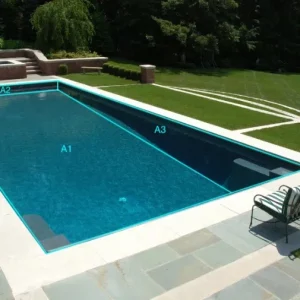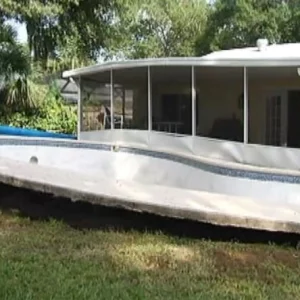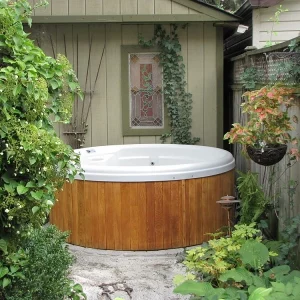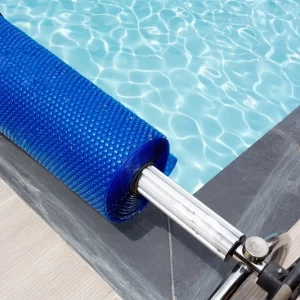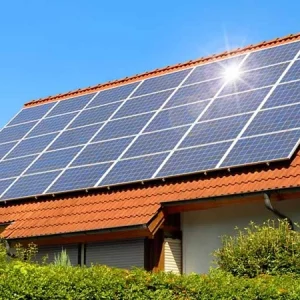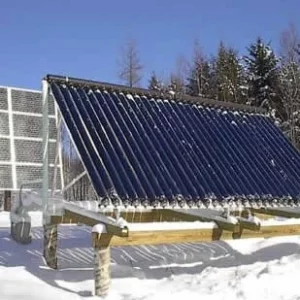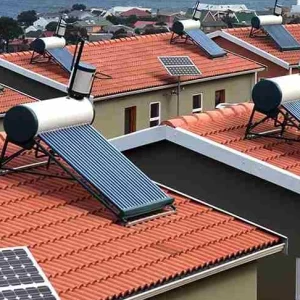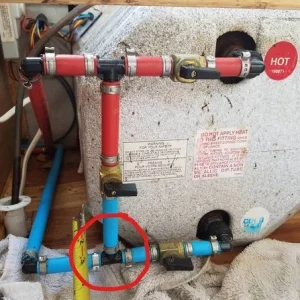Swimming seasons need not end with summer. You can also extend them without investing more from your pocket. Yes, It’s possible with a cost effective solution. In this ultimate guide, we’ll unveil the secret behind the magic of solar covers: Just how warm can they make your pool?
First let’s brush up some basics.
Understanding Solar Pool Covers
Before we delve into the specifics, it’s essential to understand what a solar pool cover is. Also known as a solar blanket, it’s a cover designed to absorb the sun’s heat and transfer it to your pool water. The cover minimizes evaporation, keeping your pool warmer for longer periods.
How Does a Solar Pool Cover Work?
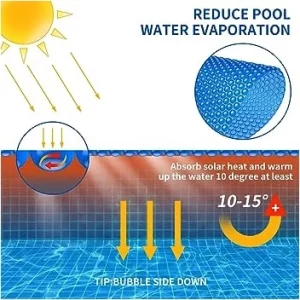 The solar pool cover is made of a specialized material that contains numerous tiny air pockets or bubbles. When sunlight hits the cover, it passes through these air pockets and is absorbed by the pool water beneath.
The solar pool cover is made of a specialized material that contains numerous tiny air pockets or bubbles. When sunlight hits the cover, it passes through these air pockets and is absorbed by the pool water beneath.
The science behind how a solar pool cover works revolves around the principles of solar energy absorption, heat transfer, and heat retention.
Sunlight is composed of photons, which are small packets of energy.
When photons strike the water molecules in the pool, they transfer their energy, causing the water molecules to vibrate more rapidly.
This increased molecular movement results in higher temperatures, effectively heating the pool water.
Answering the primary question: how warm does a solar cover heat a pool?
The answer can vary depending on a range of factors. However, in optimal conditions, a solar pool cover can raise the water temperature by 5 to 15 degrees Fahrenheit. The efficiency of heat absorption largely depends on various factors that are discussed below
Solar Exposure
It goes without saying that solar exposure plays a crucial role in the efficiency of solar pool covers. The more direct sunlight your pool receives, the more heat your cover can absorb and transfer to the pool water.
Cover Color and Quality
The color and quality of the solar pool cover also matter. A dark-colored cover tends to absorb more heat. However, it’s worth noting that the quality of the cover, including its thickness and bubble size, can also affect its heat absorption capacity.
Geographical Location
Your geographical location can also influence how warm a solar cover can heat your pool. For instance, a solar pool cover might be more efficient in sunny Florida than in foggy San Francisco.
Maximizing the Efficiency of Your Solar Pool Cover
To maximize the heating potential of your solar pool cover, consider the following tips:
Ensure Full Coverage
Ensure that your solar cover fully covers the pool surface. Any exposed area allows heat to escape, reducing the cover’s effectiveness.
Optimize Pool Placement
If possible, place your pool in an area that gets maximum sun exposure. The more sunlight your cover captures, the warmer your pool can get.
Regularly Maintain Your Cover
Clean and maintain your solar cover regularly to prolong its life and maintain its efficiency.
Solar Pool Cover: An Environmentally Friendly Choice
Beyond their heating capabilities, solar pool covers are an environmentally friendly choice. They utilize renewable solar energy and reduce water evaporation, saving water and energy resources.
Solar Pool Covers Vs. Pool Heaters
While pool heaters can efficiently warm your pool, they come with significant energy costs. Conversely, a solar pool cover uses renewable energy, making it a cost-effective, eco-friendly solution. Here is a comparative description of both as per various aspects:
The Limitations of Solar Pool Covers
While solar pool covers can help maintain and slightly increase your pool’s temperature, they won’t turn your pool into a hot tub. Their heating potential is largely dependent on external factors, such as sunlight exposure and ambient temperature.
Some of the other limitations are discussed below:
- Weather Dependence: Solar pool covers rely on sunlight to heat the pool water. In cloudy or overcast weather, their heating effectiveness is reduced, and they may not be as efficient during colder seasons or in areas with limited sunlight.
- Slower Heating: Compared to pool heaters, solar pool covers provide a slower heat-up time. It may take longer for the pool water to reach the desired temperature, especially during periods of low sunlight or at the beginning of the swimming season.
- Inconvenience of Removal: While solar covers are relatively easy to put on, some pool owners may find it cumbersome to remove and store the covers daily, especially in larger pools. The use of a reel can alleviate this inconvenience.
- Limited Temperature Control: Solar pool covers passively heat the pool water based on available sunlight, making it challenging to have precise control over the pool’s temperature. In situations where specific temperatures are required, it can’t offer more precise control.
- Aesthetic Concerns: Some pool owners may find the appearance of a solar pool cover less visually appealing compared to an uncovered pool. Although solar covers are effective, they can affect the aesthetics of the pool area.
Related Articles:
Conclusion
In essence, a solar pool cover can be a cost-effective, eco-friendly way to keep your pool warm. It can raise the water temperature by 5 to 15 degrees Fahrenheit under optimal conditions. While its heating potential depends on various factors, implementing proper practices can help maximize its efficiency. Remember, while a solar cover won’t replace a traditional pool heater, it offers a sustainable solution for mild temperature boosts and prolonging your swimming season.
- Swimjoy Solar Panels 2023: In-Depth Review & Insights - May 15, 2024
- How to Calculate Your Pool’s Square Footage Accurately? - October 15, 2023
- Pool Expansion Guide: Making Your Existing Pool Bigger! - October 15, 2023


